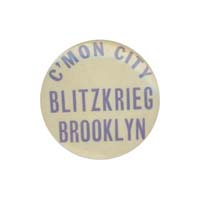
faculty activists
After 1935, faculty at CCNY is increasingly concerned about the spread of fascism in Europe. Many of the young, untenured faculty members also feel concerned about job security. In response, they form the Instructional Staff Association and the College Teachers Union and join the campus’s Anti-Fascist Association and the Communist party.
_thumb.jpg) Two-thirds of the faculty at the city’s public colleges are instructors
or tutors. Instructors teach fifteen hours a week at substandard salaries.
They have no tenure and can be dismissed at any time. Most of these faculty
members are young, many are graduates of the City College and, like their
students, they come from poor immigrant backgrounds.
Two-thirds of the faculty at the city’s public colleges are instructors
or tutors. Instructors teach fifteen hours a week at substandard salaries.
They have no tenure and can be dismissed at any time. Most of these faculty
members are young, many are graduates of the City College and, like their
students, they come from poor immigrant backgrounds.
Younger activist faculty creates the CCNY Instructional Staff Association
in 1932 to fight for increases in salary, promotion procedures, and tenure
for the lower-paid teaching staff. By 1937, the association claims that
more than 100 faculty members have been promoted from the rank of tutor
to that of instructor as a result of their efforts.
 In 1935 faculty and staff organize the Anti-Fascist Association at CCNY.
It holds monthly educational meetings and publishes a monthly newsletter.
Some 200 individuals join, including senior faculty. Representatives frequently
spoke at student anti-war rallies
In 1935 faculty and staff organize the Anti-Fascist Association at CCNY.
It holds monthly educational meetings and publishes a monthly newsletter.
Some 200 individuals join, including senior faculty. Representatives frequently
spoke at student anti-war rallies
 During the Civil War in Spain, CCNY faculty and staff establish a committee to provide humanitarian aid to the Spanish population. After the defeat of the Spanish Republic, faculty organizations aid refugees from Spain.
During the Civil War in Spain, CCNY faculty and staff establish a committee to provide humanitarian aid to the Spanish population. After the defeat of the Spanish Republic, faculty organizations aid refugees from Spain.
 The New York College Teachers Union is organized in 1935 as the College Section
of the Teachers Union and two years later becomes Local 537 of the American
Federation of College Teachers.
The New York College Teachers Union is organized in 1935 as the College Section
of the Teachers Union and two years later becomes Local 537 of the American
Federation of College Teachers.
 The most important achievements of the College Teachers Union at the city’s public colleges in 1938 include winning the right of tenure for the lowest paid full-time faculty, as well as securing major democratic reforms, such as department chairs elected by fellow faculty, faculty responsibility for departmental curricula, and a representative faculty governance council that gave faculty an administrative voice on each campus.
The most important achievements of the College Teachers Union at the city’s public colleges in 1938 include winning the right of tenure for the lowest paid full-time faculty, as well as securing major democratic reforms, such as department chairs elected by fellow faculty, faculty responsibility for departmental curricula, and a representative faculty governance council that gave faculty an administrative voice on each campus.
 College Teachers Union members march in their caps and gowns in the May Day Labor Parade on May 1, 1938, along with several hundred thousand workers from other unions.
College Teachers Union members march in their caps and gowns in the May Day Labor Parade on May 1, 1938, along with several hundred thousand workers from other unions.





